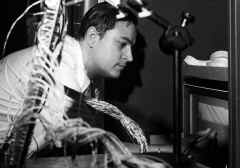
Prof. John Staudhammer created an early computer graphics research group in the Electrical Engineering Department of North Carolina State University (Raleigh NC) around 1970. I joined the group in 1972. The group lasted through about 1978. There were a number of publications (5 in SIGGRAPH '74, 3 in SIGGRAPH '78) and successful graduates from the group. John attracted and encouraged creative, motivated students and it was a marvelous environment! We never had much money and a lot of the equipment we had was second-hand or home-brew, but we all had a chance to do and learn an awful lot about graphics. Thanks, John!

Our main machine was an Adage AGT-30, a marvelous machine for its day (1970?). It had a calligraphic display for the main console, driven by a hybrid analog-digital 3D matrix multiplier. Adage did a nice job on the software and it was one of the earliest machines with software that assumed the user had an interactive display with interactive devices as standard equipment. The text editor was set up so you could use the button box (or foot pedals) to search and replace, for example.
It was a 30 bit machine, instructions having 15 bits of op code and 15 bits of address or immediate data. The graphics display lists had 15 bits each of X,Y,Z. The instruction set had hardware indirects so linked list data structures for graphics were a real natural. I remember someone's code with a comment like "POINTER TO THE FIRST POINT POINTER POINTER". There was a FORTRAN compiler and you could put in-line assembly code in that also. Nice symbolic de-bugger too as I remember. Single user machine of course. It supported overlays for really BIG programs.
It had two 7-track tape drives, a card reader, teletype printer and some
removable hard disks too (maybe 256K bytes/disk?). Mostly discrete transistor
technology, but the ALU was TTL. Originally 8K x 30 core memory, later upgraded
to 32K x 30. The machine took up 4 racks plus the two tape drives and two
disk drives. Needed lots of air conditioning and continual maintenance.
We also had a Varian 620 mini with 8K x 16 of core memory (actually a Data Machines Inc. 620 - precursor to Varian). We used this to control various peripherals and to run hidden surface display code for shaded raster graphics. It originally had just a paper tape punch/reader for I/O (and a Model 33 teletype for a console), but I later built an interface and controller for a pair of Ampex 9-track tape drives and wrote a very crude OS for it. Photo - Debbie Ogden waiting for paper tape to load
At some time, we inherited an Adage Ambilog 200 machine (kind of a precursor to the AGT series). It had been used in the biomath department, then transferred to Computer Science - they couldn't ever get it to work again, so our lab inherited it. Marc Howard, an undergraduate, adopted it as his own and got it working just fine. Like the AGT, the Ambilog also had a hybrid analog-digital arithmetic unit and vector CRT console. There were also two 7-track tape drives, but no disk system, for this machine. Ambilog advertisement.
1966 - Ambilog 200 in the biomath dept. - photo credit
Please let me know if you find a
console like this for sale.
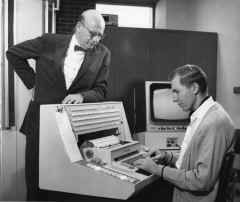
Jeff Eastman, Dave Wooten, and Ed Tripp designed a very fast asynchronous parallel processor for graphics operations. Debbie Ogden later started building it (wire-wrapped ECL) but never got it to a working stage. See the article in SIGGRAPH 74 for info on the design.
AGT-30 - Calligraphic (stroke drawing) display with 3-D transformation hardware. Characters were drawn as vector lists too. Display list processing was via DMA transfer from the CPU memory, so integrating applications and graphics was really nifty.
Color Raster Display - In 1972 Glen Williamson rigged up an analog
video disk (old slo-mo magnetic disk) so you could read red, green, and blue
frames, and write one scan line at a time. Glen also modified a Sony TV for
use as an RGB monitor. Jeff Eastman built a digital interface to this using
a run-length coded buffer. Back then, almost no-one could afford all the
RAM it would take to build an actual frame buffer!
Debbie Ogden with her textile paint system
 |
Analog/video wizard Glen Williamson
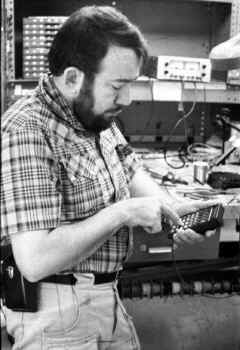 |
color display system
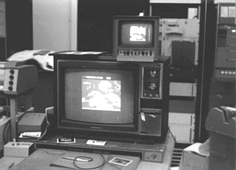 |
Programmable Raster Display - In 1977-78 I designed and built the fore-runner to the Ikonas system, a programmable 32-bit graphics processor (based on AMD 2901) and a frame buffer (512x512x2 or 256x256x8). Ray Stroh wrote a micro-code compiler for it and we set things up so display lists could be transformed on the AGT-30 and transferred to my machine for drawing. See my paper in SIGGRAPH 78 for a block diagram. I also designed some matrix multiplier boards, but we never actually did anything much with them. This system was probably the very first programmable GPU ever.
Stereo Display - Glen and I experimented with several stereoscopic display techniques. We got a couple of B&W video projectors from federal surplus and projected them through polarizing filters. In another set-up we rigged up a half-silvered mirror to combine the images from two cross-polarized monitors.
Augmented Reality - Glen and I also rigged up two video cameras to look at a scene in stereo. We combined stereo raster graphics from my display system and used a polarization stereoscope to view the result. I used it to try and fit virtual spline patches to real objects. See my paper in SIGGRAPH 78 for info.
Plotters - We also acquired a Calcomp drum plotter and an HP X-Y pen plotter for which we developed hardware and software interfaces -everything required custom work in those days - no USB ports and downloadable drivers.
Some Research Results
|
3D modeling & display (1973-74?) photo thanks to Jeff Eastman |
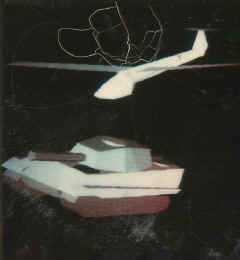 3D modeling & display (1973-74?) |
Digitec - John Staudhammer formed a company in his basement (with Ed Tripp, Phil Frankenstein, and Marc Howard) and built a couple of graphics systems - a Run Length Coded frame buffer for Chuck Csuri's Computer Graphics Research Group (CGRG) at Ohio State and a 512x512x8 frame buffer using 4Kx1 DRAMs for Bob Evans' oceanographic imaging group at Univ. of Miami.
Ikonas - Mary Whitton and I started Ikonas Graphics Systems (in a back bedroom, rather than the basement) based on the programmable raster display processor I designed as a grad student. We sold about 400 systems. Ikonas history article in IEEE Computing Edge (page 25)
The AGT-30 had a really nifty version of Space War. You could use dials to set gravity, thrust, etc., use the button box for rotation and weapon firing, and use the foot pedals for thrust control!
Debbie Ogden once had to write a 3-D tic-tac-toe (4x4x4) program for an AI class. So of course, she wrote a nice 3-D display routine for the AGT-30 so you could see the board as you played. It was amusing to see her classmates playing via text-only time-share terminals while we had this great interactive 3-D view of the action.
Nick England Personal Home Page
Last modified: 14 Oct 2021